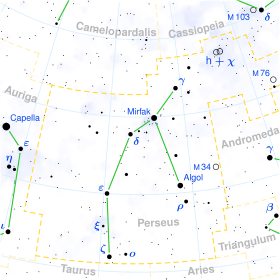16 Persei
| Observation data Epoch J2000 Equinox J2000 | |
|---|---|
| Constellation | Perseus |
| Right ascension | 02h 50m 35.05979s[1] |
| Declination | 38° 19′ 07.1080″[1] |
| Apparent magnitude (V) | 4.22[2] |
| Characteristics | |
| Spectral type | F2III[3] |
| U−B color index | +0.08[4] |
| B−V color index | +0.34[4] |
| Astrometry | |
| Radial velocity (Rv) | +14.00[5] km/s |
| Proper motion (μ) | RA: +195.77[1] mas/yr Dec.: -109.98[1] mas/yr |
| Parallax (π) | 27.01 ± 0.19[1] mas |
| Distance | 120.8 ± 0.8 ly (37.0 ± 0.3 pc) |
| Absolute magnitude (MV) | 1.38[2] |
| Details | |
| Mass | 1.92[6] M☉ |
| Radius | 3.2[6] R☉ |
| Luminosity | 23.36[2] L☉ |
| Surface gravity (log g) | 3.72[7] cgs |
| Temperature | 7,004[7] K |
| Metallicity [Fe/H] | -0.04[2] dex |
| Rotational velocity (v sin i) | 149[3] km/s |
| Other designations | |
| Database references | |
| SIMBAD | data |
16 Persei (16 Per) is a class F2III[3] (yellow-white giant) star in the constellation Perseus. Its apparent magnitude is 4.22[2] and it is approximately 120.8 light years away based on parallax.[1]
It has two reported companions: B, with magnitude 12.8 and separation 76.7", and C, with magnitude 10.43 and separation 234".[8]
References
- 1 2 3 4 5 6 Van Leeuwen, F. (2007). "Validation of the new Hipparcos reduction". Astronomy and Astrophysics. 474 (2): 653. arXiv:0708.1752. Bibcode:2007A&A...474..653V. doi:10.1051/0004-6361:20078357. Vizier catalog entry
- 1 2 3 4 5 Anderson, E.; Francis, Ch. (2012). "XHIP: An extended hipparcos compilation". Astronomy Letters. 38 (5): 331. arXiv:1108.4971. Bibcode:2012AstL...38..331A. doi:10.1134/S1063773712050015. Vizier catalog entry
- 1 2 3 Hoffleit, D.; Warren, W. H. (1995). "VizieR Online Data Catalog: Bright Star Catalogue, 5th Revised Ed. (Hoffleit+, 1991)". VizieR On-line Data Catalog: V/50. Originally published in: 1964BS....C......0H. 5050. Bibcode:1995yCat.5050....0H.
- 1 2 Mallama, A. (2014). "Sloan Magnitudes for the Brightest Stars". The Journal of the American Association of Variable Star Observers. 42: 443. Bibcode:2014JAVSO..42..443M. Vizier catalog entry
- ↑ Wilson, R. E. (1953). General Catalogue of Stellar Radial Velocities. Carnegie Institution for Science. Bibcode:1953GCRV..C......0W. LCCN 54001336.
- 1 2 Allende Prieto, C.; Lambert, D. L. (1999). "Fundamental parameters of nearby stars from the comparison with evolutionary calculations: Masses, radii and effective temperatures". Astronomy and Astrophysics. 352: 555. arXiv:astro-ph/9911002. Bibcode:1999A&A...352..555A. Vizier catalog entry
- 1 2 David, Trevor J.; Hillenbrand, Lynne A. (2015). "The Ages of Early-Type Stars: Strömgren Photometric Methods Calibrated, Validated, Tested, and Applied to Hosts and Prospective Hosts of Directly Imaged Exoplanets". The Astrophysical Journal. 804 (2): 146. arXiv:1501.03154. Bibcode:2015ApJ...804..146D. doi:10.1088/0004-637X/804/2/146. Vizier catalog entry
- ↑ Mason, Brian D.; Wycoff, Gary L.; Hartkopf, William I.; Douglass, Geoffrey G.; Worley, Charles E. (2001). "The 2001 US Naval Observatory Double Star CD-ROM. I. The Washington Double Star Catalog". The Astronomical Journal. 122 (6): 3466. Bibcode:2001AJ....122.3466M. doi:10.1086/323920. Vizier catalog entry
This article is issued from
Wikipedia.
The text is licensed under Creative Commons - Attribution - Sharealike.
Additional terms may apply for the media files.
